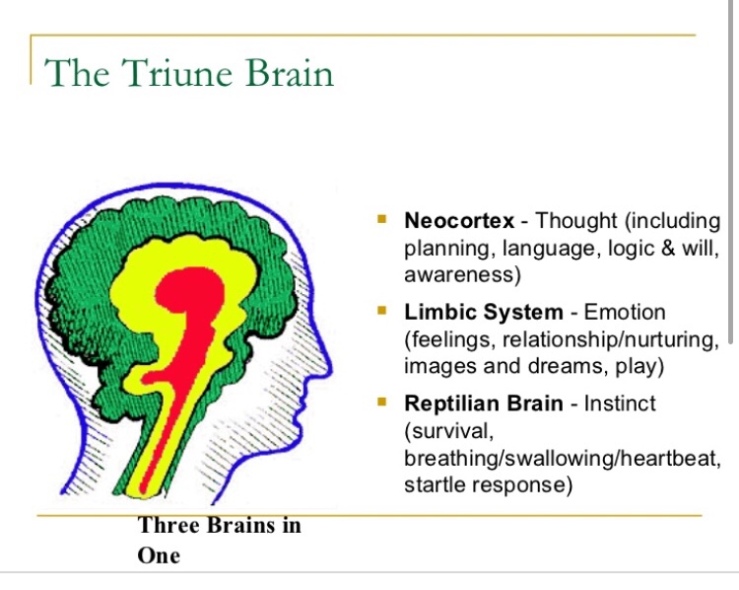
The brain and mind have been an ever intriguing subject for decades. Dan Siegel defines the mind “as an embodied and relational process that regulates the flow of energy and information” and the brain as the organ that houses the mind. Dan Siegel is the creator of Interpersonal Neurobiology, an up and coming theory that has been gaining traction in the last decade. It is defined as primarily a theory and practical working model which describes human development and functioning as being a product of the relationship between the body, mind, and relationships. It theorizes that wellbeing can be cultivated when all parts of the brain are “integrated”, and there are 9 levels of integration.
Today I will be describing one type of integration, vertical integration, that I teach on a regular basis in my therapy with individuals. It is important to know the parts of the brain in order to know how to talk to and soothe them when they are distressed. I will focus on the parts that talk to each other using a “vertical” or “up and down” pathway in the brain. One goal in therapy can be to have these brain parts talk to each other in a harmonious way to help reduce distress. This is no easy task, and certainly takes practice.

(Photo Credit: https://wholebodyhealingeugene.com/2018/02/23/triune-brain/)
#1 Brain Stem aka “lizard brain”
The brain stem is the oldest part of our brains. Why is that important? It holds the most “power” or influence in how we respond to threat. The older the part of the brain, the more “rev” it has in its engine when it comes to our responses. The brain stem houses involuntary functions such as heart rate, breathing, digestion, muscle contraction and release. At one point in time, when our nervous systems were primarily brain stem, it was adaptive because our predators weren’t very big or scary and we could simply constract or move a set of muscles and avoid a threat. When we are scared nowadays it is the brain stem that starts up the panic attacks, high anxiety, and changes in our breathing, heart rate, and digestion in hopes that this response will still work well for the “threats” we face today. The tough part about this response is that it only works well if we are in physical danger. Now we often “perceive threat” and equate emotional danger=physical danger. In therapy, we can learn how to compassionately soothe this part of the brain by learning distress tolerance skills and relaxation exercises when the threat is not actual physical danger.
#2 Mid Brain aka “Mammalian brain”
In terms of evolution, this part evolved next, which makes it the second most “powerful”. Evolution is always building upon systems and does not necessarily take away systems so this part had to “learn” how to work with the brain stem. When we don’t have an integrated brain, this part can be “hijacked” by the brain stem and can be convinced that there is a threat present because of the body’s response. The mid-brain houses our “flight/fight” responses and our lesser known responses “faint/freeze” in addition to our different felt emotions. This part also houses some forms of memory, our attachments to others, and also is where motivation lies. In therapy we can learn how you attached to your parents in childhood, learn what core beliefs we’ve created from past experiences that affects us, which ways you respond to perceived threat, and what emotions you are familiar with, pushing down, or expressing in a way that is hurting yourself or others. You can also learn what your predominant attachment style is, how it affects your relationships to others, and what is needed to reach a place of security, love, openness, and emotional safety in your relationships.
#3 Upper brain aka “neo-cortex”
This is our “map maker” or the area that makes sense of our internal and external world. It is the part that helps integrate and create that harmonious flow of wellbeing between parts of the brain. Like a parent, it helps model, regulate, and teach the other parts how to work together. This part can houses the skills to regulate your bodily reactions and sensations, creativity, complex social bonds, mindfulness, attuned communication, emotional balance, response flexibility, empathy, self-awareness, fear modulation, intuition, and morality. This part of the brain goes offline when the mid and lower brain decides to “hijack” the brain (with it’s older seniority power in a sense) and prepare the body and mind for threat. In therapy, you can learn to use this part of your brain more as if it were a muscle that needs constant practice and strengthening. You can learn to bring it back online to soothe the other parts of the brain. It is the the part of the brain that reminds yourself that you are not necessarily in any physical danger just because you feel fear and that a threat may not be present even though you are “perceiving” one. Although the brain does not “physically” become stronger, you can strengthen the beneficial neural pathways that work to help your mind become more integrated and it becomes easier to practice the skills needed for cultivating wellbeing. Therapy can be the vehicle to help you practice.
If you are more of a visual learner, check out Dan Siegel himself teaching more about Vertical Integration on YouTube using his hand model: https://www.youtube.com/watch?v=f-m2YcdMdFw. If you are a parent, you can teach your kids this concept!
Stay tuned for Part 2.
